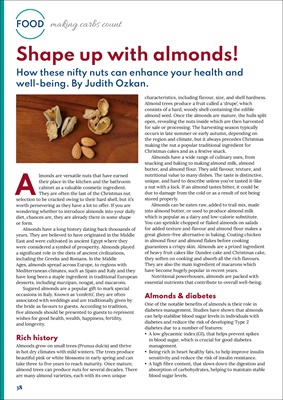
38
FOOD making carbs count
Shape up with almonds!
How these nifty nuts can enhance your health and
well-being. By Judith Ozkan.
Almonds are versatile nuts that have earned
their place in the kitchen and the bathroom
cabinet as a valuable cosmetic ingredient.
They are often the last of the Christmas nut
selection to be cracked owing to their hard shell, but it's
worth persevering as they have a lot to offer. If you are
wondering whether to introduce almonds into your daily
diet, chances are, they are already there in some shape
or form.
Almonds have a long history dating back thousands of
years. They are believed to have originated in the Middle
East and were cultivated in ancient Egypt where they
were considered a symbol of prosperity. Almonds played
a significant role in the diets of ancient civilizations,
including the Greeks and Romans. In the Middle
Ages, almonds spread across Europe, to regions with
Mediterranean climates, such as Spain and Italy and they
have long been a staple ingredient in traditional European
desserts, including marzipan, nougat, and macarons.
Sugared almonds are a popular gift to mark special
occasions in Italy. Known as 'confetti', they are often
associated with weddings and are traditionally given by
the bride as favours to guests. According to tradition,
five almonds should be presented to guests to represent
wishes for good health, wealth, happiness, fertility,
and longevity.
Rich history
Almonds grow on small trees (Prunus dulcis) and thrive
in hot dry climates with mild winters. The trees produce
beautiful pink or white blossoms in early spring and can
take three to five years to reach maturity. Once mature,
almond trees can produce nuts for several decades. There
are many almond varieties, each with its own unique
characteristics, including flavour, size, and shell hardness.
Almond trees produce a fruit called a 'drupe', which
consists of a hard, woody shell containing the edible
almond seed. Once the almonds are mature, the hulls split
open, revealing the nuts inside which are then harvested
for sale or processing. The harvesting season typically
occurs in late summer or early autumn, depending on
the region and climate, but it always precedes Christmas
making the nut a popular traditional ingredient for
Christmas cakes and as a festive snack.
Almonds have a wide range of culinary uses, from
snacking and baking to making almond milk, almond
butter, and almond flour. They add flavour, texture, and
nutritional value to many dishes. The taste is distinctive,
unique, and hard to describe unless you've tasted it-like
a nut with a kick. If an almond tastes bitter, it could be
due to damage from the cold or as a result of not being
stored properly.
Almonds can be eaten raw, added to trail mix, made
into almond butter, or used to produce almond milk
which is popular as a dairy and low-calorie substitute.
You can sprinkle chopped or flaked almonds on salads
for added texture and flavour and almond flour makes a
great gluten-free alternative in baking. Coating chicken
in almond flour and almond flakes before cooking
guarantees a crispy skin. Almonds are a prized ingredient
of heavy fruit cakes like Dundee cake and Christmas cake,
they soften on cooking and absorb all the rich flavours.
They are also the main ingredient of macarons which
have become hugely popular in recent years.
Nutritional powerhouses, almonds are packed with
essential nutrients that contribute to overall well-being.
Almonds & diabetes
One of the notable benefits of almonds is their role in
diabetes management. Studies have shown that almonds
can help stabilise blood sugar levels in individuals with
diabetes and reduce the risk of developing Type 2
diabetes due to a number of features:
• A low glycaemic index (GI), that helps prevent spikes
in blood sugar, which is crucial for good diabetes
management.
• Being rich in heart healthy fats, to help improve insulin
sensitivity and reduce the risk of insulin resistance.
• A high fibre content, that slows down the digestion and
absorption of carbohydrates, helping to maintain stable
blood sugar levels.